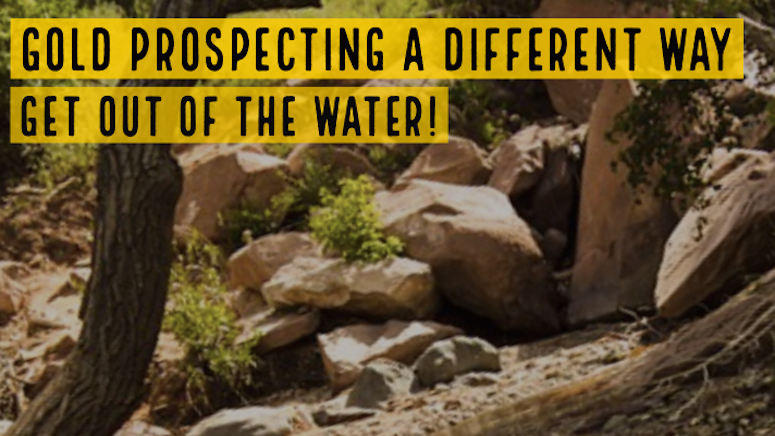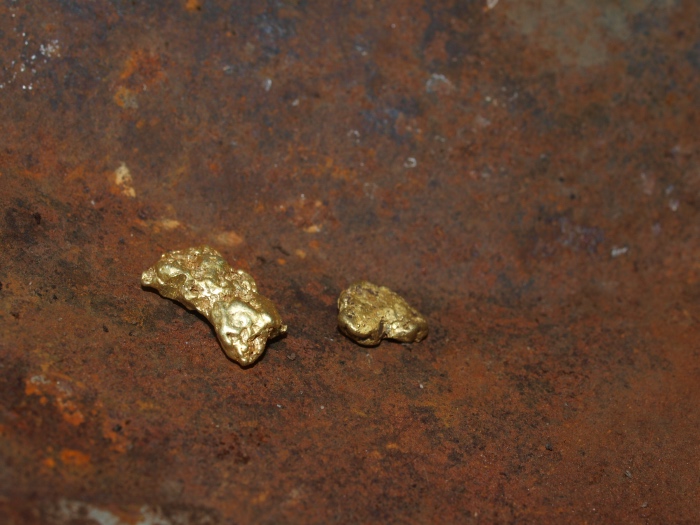
Placer miners gravitate toward creeks and rivers for a very good reason. The forces of time and gravity have forced gold to move down into the waterways. It finds its way into the creeks and rivers where a prospector can work the concentrations that form within the gravels.
I would never tell you to avoid the creeks and rivers. The fact is that this is still a good place to start your search. If you are in a known gold producing areas, all it takes is a shovel, sluice box and a hard days work. You will certainly find gold.
But these areas have been mined hard for well over 100 years now. Hitting a rich pocket of gold that hasn’t already been mined gets a little harder each season. It takes a long time for these placers to replenish.
Move Upstream and Uphill
Pretty much all of the gold that you find in a creek with your pan or sluice eroded from a vein uphill from your present location. Just because it concentrates within creeks and rivers doesn’t mean this is the only place you will find gold.
In fact, I am finding more and more that I have better success by looking for areas that other people aren’t going. Reworking the same areas that are hammered by everyone else can still result in some gold, but it is hard earned.
Rather than reworking old placers, I am having success exploring spots that others overlook. These are small side gulleys (that are often dry) draining into the main river channel. These small drainages may flow a little bit in the springtime during high water events, but generally these are dry washes. Sometimes they are very steep and full of poison ivy. Not for the faint of heart!
There’s no guarantee that these areas have gold, but research is always important. The sign of past mining activity is usually less evident in these areas because water wasn’t available to wash the gravels. In this case you will need to be observant. Using Google Earth to look for smaller diggings can be very helpful.
Lode mines on the hillsides is also a good indicator. Miners were digging into veins that plunged into the mountain, but in most cases these veins were outcropped when the miners first found them. Rough gold has been shedding off of that outcrop for thousands of years before it was mined. The old timers may have worked the adjacent ground for scattered specimens, but they didn’t have metal detectors like we do! Consider scanning the hills directly below small lode mines up in the hills above the river.

Dry Digging
The other reason that miners want to work the rivers and creeks is because of the water. Placer mining works a lot better with some water. When you move up out of the river bottom the water goes away and you’ve got more challenges.
How do you sample an area when you can’t even use a gold pan? It certainly isn’t as easy, but there are ways.
Metal detectors are excellent tools if the gold in your area is detectable. This means that the gold needs to be large enough to hear. Gold nuggets are great, flakes are okay, but tiny specks of gold dust won’t do. Even the best detector can’t hear a speck of gold dust. In this case, you will need other options.
You could collect promising looking material down to the water and pan it out. This is time consuming, but it might be a good option. You could also pack water up with you, even though it is very heavy.
But how do you go about finding promising material to wash out? This could be at old workings other miners have already dug, an ancient tertiary river channel, or a nice dark mineral rich soil that just looks promising. Remember, this is what prospecting is all about. Not everything will “pan out,” but you might just get lucky!
Let’s say you hit a nice pocket of auriferous material, but you are way up on the hillside far from any water. How do you work it? In most cases your only good option is going to be a drywasher. Many prospectors dislike prospecting because it is hot, dirty work. But it can definitely pay off if you are right on top of a rich deposit.
Don’t Follow the Crowds
It kind of amazes me how many people simply don’t do their own thinking. They just go somewhere because that is where everyone else goes. I don’t want GPS coordinates to your prospecting location… I want to find my own location!
There is still SO MUCH GOLD OUT THERE left to find. You don’t have to pound the same areas over and over. Do some research, strap on a good pair of boots and get out and explore!
Next: Metal Detect the “Fringe” Spots to Find More Gold Nuggets

